Why Does A Cardinal Have A Bald Head?
Being a bird watcher, you might have encountered a bald cardinal at least once in your birding journey. And after witnessing one, you might have wondered, “why does a cardinal have a bald head?”
Well, cardinals lose their body and head feathers through molting. Usually, their molting period starts in the late summer and early fall; hence, these birds tend to appear bald during this period.
But molting isn’t the only reason why cardinals lose their crests or have bare patches. Some other causes are associated with baldness, which we have briefly discussed in this content. So, let’s read.
Here’s another interesting blog for you:
Is It Normal for Northern Cardinals to Have Bald Heads?
Bald-headed cardinals can look a bit alarming at first glance, especially if you’re used to their stunning crests and vibrant red feathers.
But it’s important to remember that this appearance is usually natural and temporary. While molting is the most common cause, it’s not the only reason – many backyard birdwatchers also report seeing bald cardinals more frequently during late summer, indicating a seasonal pattern.
Interestingly, both male and female cardinals can experience baldness, though it may seem more noticeable on males because of their brighter plumage.
Some cardinals might lose feathers gradually, while others seem to lose them all at once, which can result in a completely featherless head.
All The Reasons Why Does Cardinal Have A Bald Head
1. Infection Due To Parasite:
Some ornithologists believe that cardinals go bald due to lice infestation. Different mite types can infest cardinals’ plumage, damaging their feathers and causing these birdies to lose a whopping amount of feathers from their heads and other body parts.
A bad infestation can force cardinals to lose all their feathers at once. However, some cardinals fight these pesky critters by sunning, dusting, and preening. But as they can’t preen their heads, they can’t protect their head feathers from getting damaged by parasites.
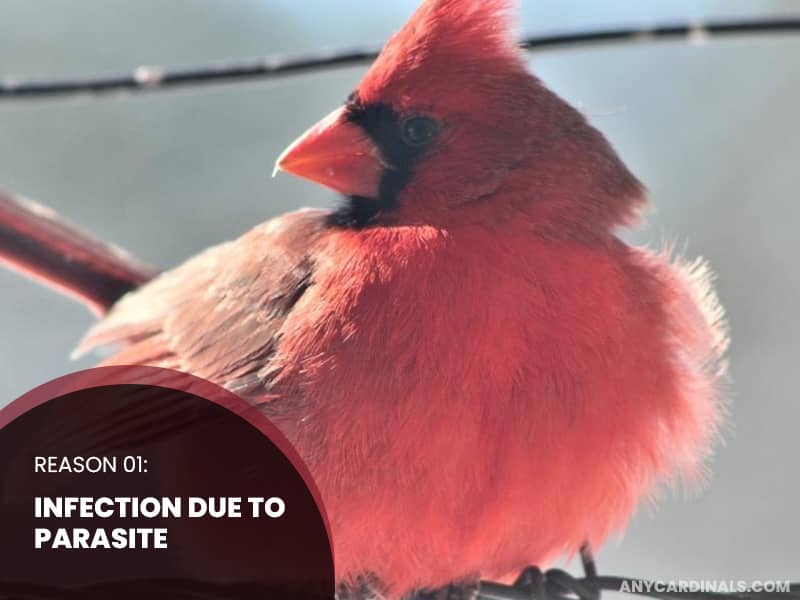
Consequently, cardinals with mite infestations appear bald even when their other body parts have healthy feathers. Now, let’s discuss what other scientists think about the parasite infestation.
When most authorities agree that the main culprit for cardinals going bald is the feather mites, some scientists indulge in arguments concerning this fact. They question whether these little parasites burrow into the cardinals’ skins or not. But most scientists accept that the lice or mites cause cardinals to lose their crests.
One thing to note is that mites and lice are not always visible to the naked eye. So, even if the bird doesn’t seem to be scratching excessively or showing external symptoms, it could still be affected.
Backyard birders can help by cleaning bird feeders regularly and keeping birdbaths fresh to reduce the risk of spreading parasites within bird populations.
2. Poor Nutrition:
Poor nutrition is another cause of why cardinals go bald. FYI, cardinals’ feathers are composed of keratin and need a good amount of protein for proper growth.
Usually, cardinals get the required protein from varied food sources, including insects, wild fruits, seeds, etc. Hence, when they face food scarcity, these birds don’t receive adequate nutrition, and thus poor plumage growth and baldness appear in cardinals.
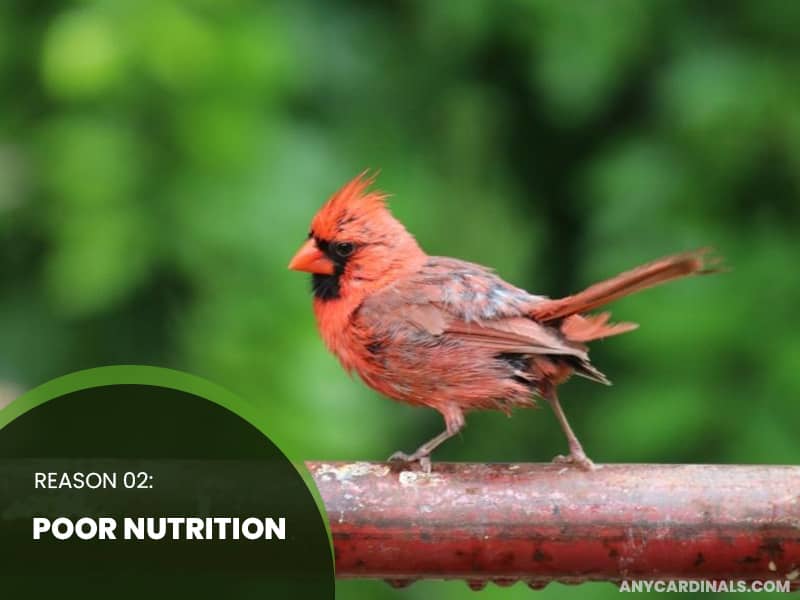
Commonly, cardinals experience food shortages when their habitat gets threatened or destroyed by unusual circumstances like drought or winter season.
So, whenever drought hits your area or when the winter season starts, you can help these birds by providing protein-rich food like black sunflower seeds in your bird feeders.
Supplementing a cardinal’s diet with mealworms, suet, peanuts, or fruits like berries can significantly support their feather regrowth. A varied, protein-rich diet not only helps in molting but also boosts the bird’s immune system, making them more resistant to parasites and environmental stressors.
3. Physical Injury:
Physically injured cardinals can have bald heads. If a cardinal brawls with a predator and somehow manages to escape, it may have a bald head or bare patches where the feathers are ripped away during the fight.
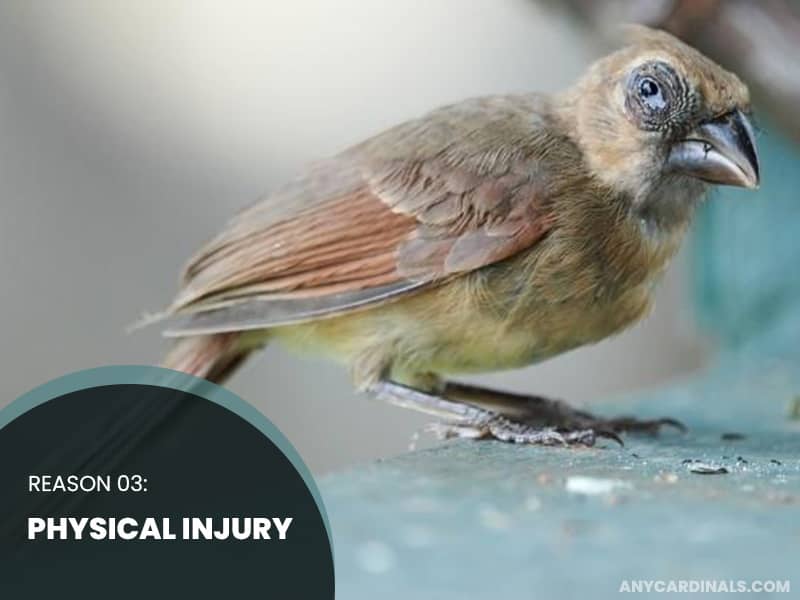
Apart from that, fire-related injuries can also make cardinals go bald. If cardinals encounter such danger and their feather shafts get severely damaged, it will take a prolonged period for cardinals to regrow their beautiful head plumage. Sadly, in extreme cases, baldness can be permanent.
Injuries don’t always come from predators. Sometimes, cardinals might fly into windows or sharp objects, leading to localized feather loss. If you’re maintaining a bird-friendly yard, consider using anti-collision stickers on your windows and keeping sharp gardening tools stored safely to avoid unintentional harm to these birds.
4. Disease:
Some cardinals appear bald due to suffering from diseases, but the baldness is temporary. The bird will regrow its head feathers after recovering from illness and will regale.
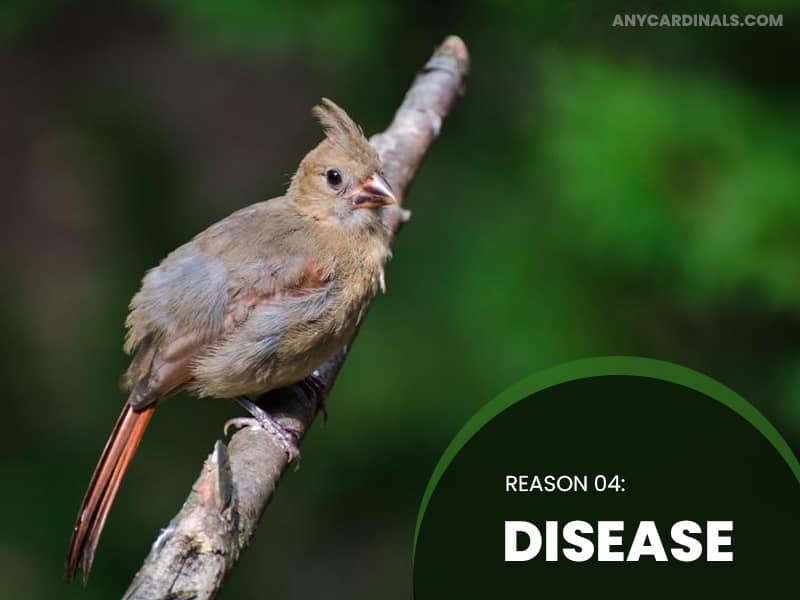
However, another common symptom of diseased cardinals is that they will have swollen skin patches or blister-like spots that protrude from the feathers.
5. Environmental Toxin:
The environmental toxin that can cause cardinals to go bald is a theory. Many researchers think the rise of herbicides, plastics, and harmful chemicals can significantly contaminate bird seed supplies.
So, if the theory turns into a fact, it will be another added cause for cardinals and other seed-eating birds suffering from malnutrition and life-taking diseases.
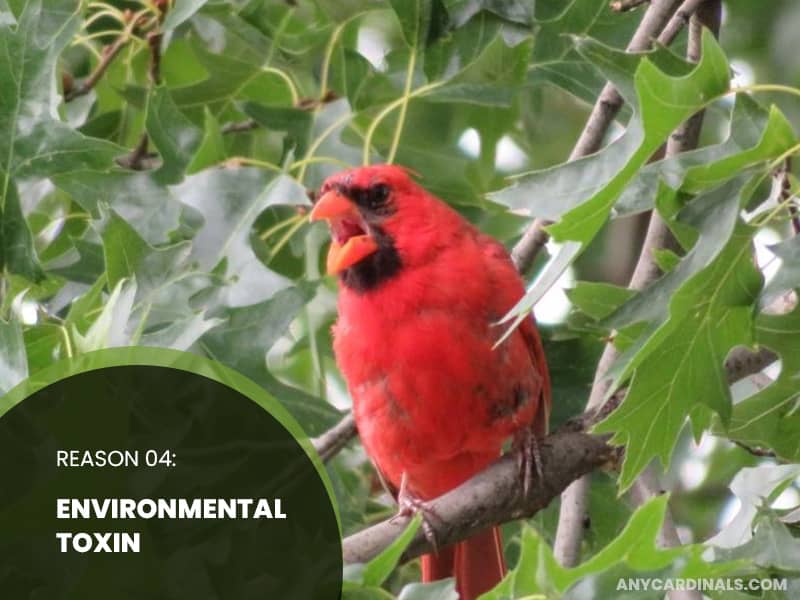
To conclude, we know that environmental toxins can have a wide-reaching negative impact on the entire ecosystem. And we can’t deny the theory that these chemicals can hamper the cardinals’ and other birdies’ health.
Long talk short, being a birder, you should accomplish all the jobs to reduce the negative impact caused by environmental pollution to help cardinals survive if you can.
How Eco-Friendly Gardening Can Help Protect Cardinals and Other Birds
If you’re serious about protecting cardinals and other backyard birds, consider switching to eco-friendly gardening practices.
Avoiding chemical pesticides and using native plants can create a healthier ecosystem that supports not only cardinals but also insects they rely on for nutrition during breeding and molting seasons.
Supporting organic seed suppliers and reducing plastic use around feeders also makes a big difference.
Cessation
Cardinals are astounding bird species, but no birders would love to witness any bald cardinals. Although these birds go bald yearly due to molting, some other reasons make them undergo baldness.
And now you know all the probable causes why these birds lose their head and other body parts’ feathers. However, we hope this content provides you with some new and valuable information to enrich your knowledge.
We expect you to stay connected with us on Facebook, Twitter & Pinterest for related, exciting content updates.
Image Credit: Canva.com/photos

